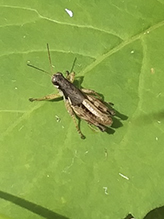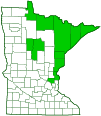forest locust
(Melanoplus islandicus)
Conservation • Description • Habitat • Ecology • Distribution • Taxonomy
Conservation Status |
|
|||||||
| IUCN Red List | not listed |
|||||||
| NatureServe | N5 - Secure |
|||||||
| Minnesota | not listed |
|||||||
Description |
||
Forest locust is a small, flightless, spur-throated grasshopper. It occurs in North America in the United States from Pennsylvania to Virginia, west to Minnesota and Iowa, and in Canada from southern Quebec to southern Manitoba. Adults are found from July to September in moderately moist to moderately dry forests, on shaded edges, openings, and trails. Colonies are usually small and scattered. It has protected status in Wisconsin, where it is listed as a Special Concern species. It is not given protected status in Minnesota. Forest locust is one of a group of five nearly identical species (Mancus Species Group) that can be distinguished only by their distribution and by details of the male reproductive structures. The head is not large, but it is slightly wider than the exoskeletal plate covering the thorax (pronotum). The top of the head is rounded in profile. The face is nearly vertical and pale greenish or yellowish. The antennae are no more than one-half the length of the body. There is a well-developed black stripe behind each compound eye that continues through the pronotum to the second abdominal segment. The body color is brownish to blackish above with some greenish below. The pronotum is saddle-shaped, flat above with the sides abruptly angled downward. The upper side is blackish-brown, the sides are pale greenish at the bottom. The rear margin is broadly rounded. There is a distinct, spiny bump (spur) below at the base of the neck, between the base of the forelegs. A broad, pale, greenish or yellowish stripe on the upper side of the abdomen runs the length of the abdomen. There are no contrasting cross bands. The first abdominal segment has a pair of flat, round, hearing organs (tympani) on the sides. The sensory appendages at the end of the abdomen (cerci) are not boot shaped. On the female the ovipositor is short. The forewings (tegmina) are uniformly dark, broadly rounded, and very short, not extending past the rear edge of the second abdominal segment. They are about three-fourths the length of the pronotum. The edges are not rolled inward. The inner edges at the base are well separated, 1⁄32″to ⅛″ (1 to 3 mm) apart. The hindwings are clear. On the hind pair of legs, the fourth segment (tibia) is usually pinkish, sometimes bright red. On all of the legs, the end section corresponding to the foot (tarsus) has three segments. |
||
Size |
||
|
||
Similar Species |
||
Habitat |
||
Forests edges and openings |
||
Ecology |
||
Season |
||
July to September |
||
Behavior |
||
|
||
Life Cycle |
||
Eggs overwinter |
||
Food |
||
|
||
Distribution |
||||
|
Sources Haarstad, J. 1990. The Acrididae of Minnesota. Final report submitted to the Minnesota Department of Natural Resources. 28 pp. |
|||
| 8/6/2022 | ||||
Occurrence |
||||
Scattered, not common |
||||
Taxonomy |
|||
Order |
Orthoptera (grasshoppers, crickets, and katydids) | ||
Suborder |
Caelifera (grasshoppers, locusts, and allies) | ||
| Infraorder | Acrididea (grasshoppers) | ||
Superfamily |
Acridoidea (short-horned grasshoppers and locusts) | ||
Family |
Acrididae (short-horned grasshoppers) | ||
Subfamily |
Melanoplinae (spur-throated grasshoppers) | ||
Tribe |
Melanoplini | ||
Genus |
Melanoplus (North American spur-throated grasshoppers) | ||
Synonyms |
|||
Melanoplus abortivus Melanoplus mancus islandicus |
|||
Common Names |
|||
forest locust island locust island short-wing grasshopper |
|||
Glossary
Pronotum
The exoskeletal plate on the upper side of the first segment of the thorax of an insect.
Tegmen
The modified, leathery front wing of grasshoppers and related insects that protects the hindwing. It may also serve as a camouflage, a defensive display, or a sound board. Plural: tegmina.
Tarsus
On insects, the last two to five subdivisions of the leg, attached to the tibia; the foot. On spiders, the last segment of the leg. Plural: tarsi.
Tibia
The fourth segment of an insect leg, after the femur and before the tarsus (foot). The fifth segment of a spider leg or palp. Plural: tibiae.
Visitor Photos |
|||||
Share your photo of this insect. |
|||||
| This button not working for you? Simply email us at info@MinnesotaSeasons.com. Attach one or more photos and, if you like, a caption. |
|||||
Luciearl |
|||||
 |
|||||
MinnesotaSeasons.com Photos |
|||||
|
|||||

Slideshows |
||

Visitor Videos |
|||
Share your video of this insect. |
|||
| This button not working for you? Simply email us at info@MinnesotaSeasons.com. Attach a video, a YouTube link, or a cloud storage link. |
|||
Other Videos |
|||

Created: 8/6/2022
Last Updated:


